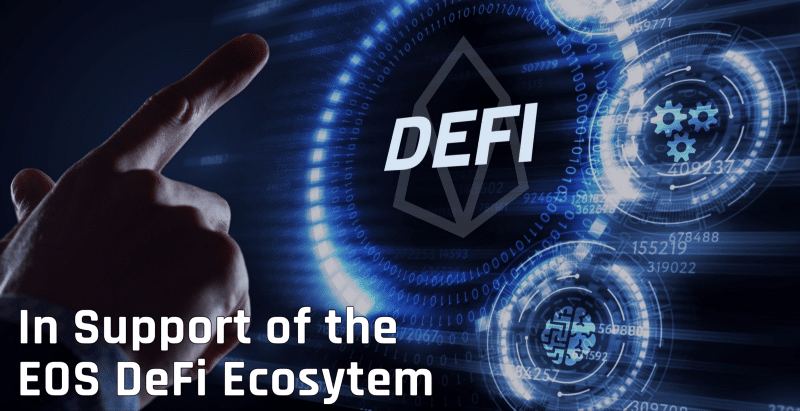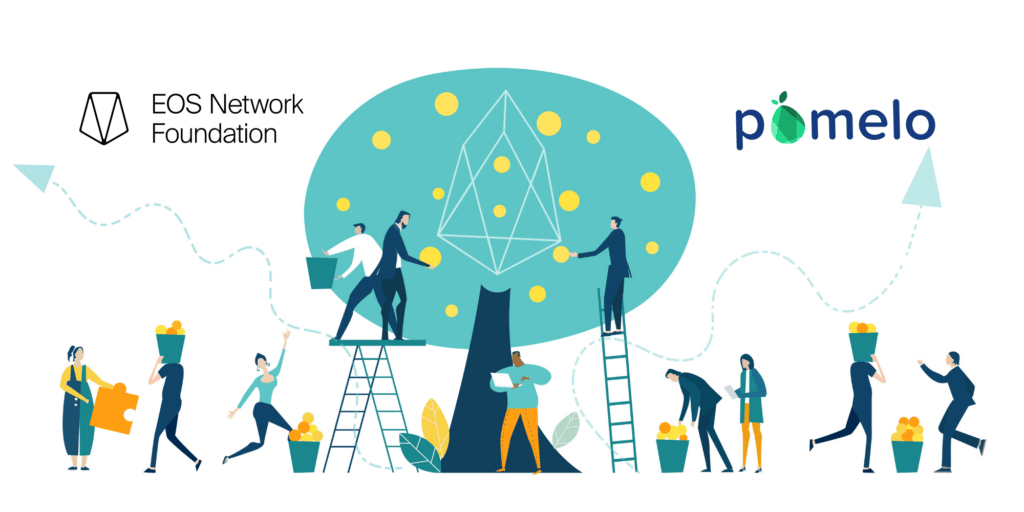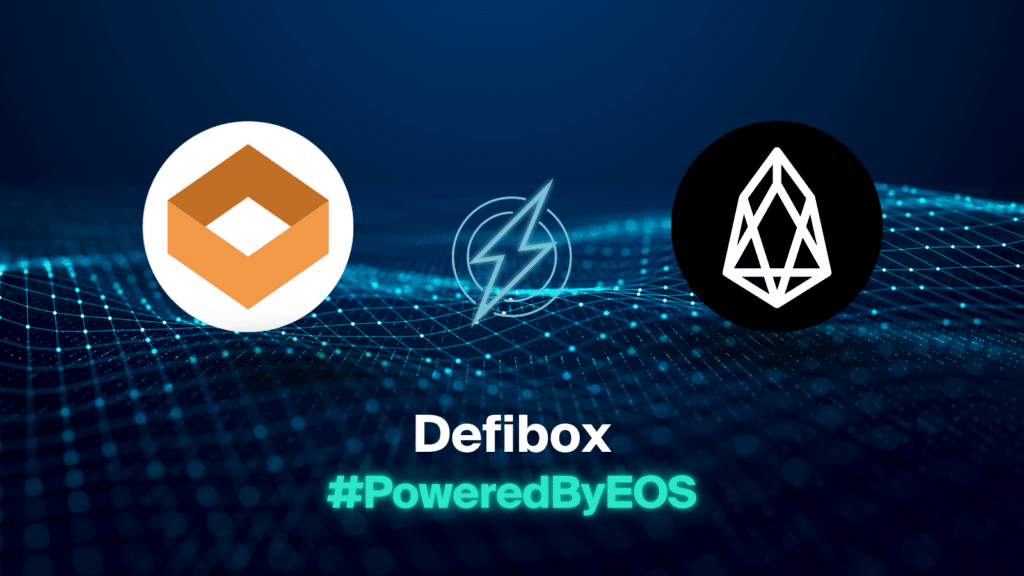Recognition Grant Wave Two: $1.1m towards EOS DeFi and interoperability projects
EOS was built to be a financial machine that was architected with decentralized finance (DeFi) at its core before DeFi was even a buzzword. EOS is a highly scalable blockchain that has been battle tested over 3+ years with sub-second latency, high throughput, and a robust permission system that can enable applications that aren’t even fathomable to build using any other technology.
Last summer the crypto ecosystem saw a major shift occur during a time when trust in the traditional financial system was being stretched thin due to the economic hardships caused by the pandemic exposing its weaknesses. In a space where the prices of cryptocurrencies dominate most of the conversations, DeFi became a new phenomenon and started gaining attention at a pace never seen before as total value locked (TVL) on-chain exploded and yield farming became a major trend.
DeFi had existed on EOS since 2018 when its first decentralized exchanges launched and continued through 2019 with the launch of its first collateral backed stablecoins and lending products. In 2020, further innovation continued to occur with the launching of automated market makers (AMM) like Defibox and Defis Network, exchange aggregators, yield farming, and bridging technology all emerging to mature a growing EOS DeFi ecosystem. As it stands today, the DeFi products on EOS are highly advanced and offer some of the best-in-class features and functionality that are comparable or superior to almost anything else on the market.
You might be wondering why EOS hasn’t experienced anywhere near the same level of explosion in TVL compared to some of its competitors even though we have some of the best products and technology. There is not a single answer to this question, as there are several variables at play. Understanding what exactly we are lacking and determining how we can best address these gaps is vital to EOS becoming the DeFi machine that it was always meant to be.
Scalability is paramount for the success of DeFi as you can’t have efficient capital markets if the underlying technology is too slow. Speed is still one of EOS’s strongest advantages with many of its EVM-based competitors still being bottlenecked with 6 second blocks. This speed advantage offers many unique advantages for EOS because it could potentially allow logic and decision making to occur on EOS for smart contract actions taking place on other blockchains after standardizing EOS’s cross-chain interoperability technology.
EOS USDT CEX Listings
Even though EOS is a highly liquid token that is available on nearly every centralized exchange, EOS alts have not had this same level of luxury in accessibility. Tether (USDT) is the most liquid stablecoin on the market, but the EOS version of USDT is only available on Bitfinex and Kucoin, which makes it quite difficult for the users in many excluded countries from accessing these fiat and stablecoin on/off ramps. For example, imagine being a whale holding a large stablecoin position on one of EOS’s most liquid exchanges like Binance or Huobi. If this person wanted to bring their liquidity on-chain to EOS to participate in DeFi, they would be required to first swap all of their stablecoins into EOS, then withdraw the EOS on-chain, then use a DEX or AMM to swap the EOS back into USDT. This is a major problem because it causes unnecessary tax events and temporary volatility risk for the token holder as well as potential slippage when swapping back into USDT from EOS if the order is large enough. Large DeFi investors that want to swap a million EOS back into USDT on-chain would also suffer high levels of slippage. This just isn’t reasonable for them to do, which is one of the reasons on-chain liquidity has remained low compared to other DeFi ecosystems. Aside from whales, this lack of EOS stablecoin on/off ramps also causes friction to those who are being paid in stablecoins for their work. For example, when a holder wants to move stablecoin capital from on-chain to their bank account, it also requires the unnecessary swaps into and out of EOS that were described above.
The ENF is working to address this bottleneck by making it a priority to get the EOS version of USDT listed on more major exchanges. To do so is going to be very capital intensive as it will require paying not only the exchange listing fees, but also providing the liquidity for professional market making and liquidity provisioning. The capital requirements to execute on this from both a technical and liquidity standpoint will require locking up even more capital than what has accumulated since turning on the 2% inflation less than two months ago. Some of you reading this may be surprised by this, which is why I’m bringing it up now so that it doesn’t come up as a shock later. Following through on this initiative is going to be one of the most impactful things that the ENF is able to do to improve on-chain DeFi, liquidity, and usability.
Interoperability
When DeFi summer took off, the gas fees on Ethereum skyrocketed to the point where it priced out most users from actively participating in its DeFi ecosystem. When this happened, it opened up the door for other gen3 blockchains to capture a significant amount of TVL and market share. They were able to do so because they had token bridges in place that allowed for ERC20 tokens to seamlessly transfer between blockchains. On top of the token bridges, the Foundations behind many of these gen3 chains have been able to tap into their treasuries to offer attractive liquidity mining rewards to incentivize capital to move to their chain to participate in their DeFi ecosystems. This kind of top level support wasn’t even an option prior to the ENF.
EOS already has bridging technology in place offering solutions to transfer both tokens and data across blockchains, however the need for setting up an EOS account is still a point of friction compared to EVM-to-EVM bridging which use the same wallet keys between chains. Interoperability will be a key component of EOS’s future success as more projects become multi-chain to expand across multiple ecosystems and communities.
Additionally, enabling EOS to be transferred to other blockchains can bring it additional utility as a collateral while also improving its accessibility and liquidity across other DeFi ecosystems. Ignoring these other ecosystems would be the equivalent of a country ignoring international trade or refusing to participate in it. EOS needs to be optimized for both imports and exports to reach its full potential.
Making it easier for existing projects to expand to EOS is another element that the ENF is working to address. This will be achieved by focusing on improving the native EOS developer experience as well as working towards EVM compatibility, which will enable existing EVM-based projects to deploy on EOS without significant code changes as well as allowing EOS to tap into an enormous pool of developer talent. In the short term, developers and projects would be able to take advantage of EVM’s mature tooling, open source standards, and knowledge base while over the medium and long term they will be exposed to many of the advantages of the EOS VM.
Developers should have a choice in what technology they want to use. Supporting additional virtual machines will also be a priority should they gain significant developer adoption. Additionally, supporting compilers for EOSIO smart contracts beyond C++ using other common programming languages is another area that EOS could benefit from in the future. EOS will become a blockchain innovation hub and settlement layer that embraces other technologies rather than fighting against them.
$1.1m Recognition Grants: DeFi + Interoperability (Wave 2)
Decentralized ecosystems require many entrepreneurs building independent businesses to make them more robust and antifragile.#EOS empowers devs to build #DeFi that isn't possible on other platforms. These projects will serve as the foundations for a new era of $EOS DeFi. https://t.co/Rc0PganPrW
— Yves La Rose (@BigBeardSamurai) October 15, 2021
As mentioned in my previous post, the ENF will be announcing a new wave of recognition grant recipients every two weeks until all five waves have been made public. This wave of recipients is the largest out of any wave with 11 out of the 34 projects being part of this group. DeFi is one of blockchain’s most valuable use cases and supporting it’s development on EOS will be a top priority for the EOS Network Foundation.
Each of the recipient projects below will receive a $100,000 grant in recognition of their continued commitment to building on EOS.
PIZZA Finance — PIZZA is a decentralized financial network on EOS with multi DeFi-related products including USDE stable-coin, Swap Aggregator, DEX, leveraged tokens, and their core decentralized lending product.
DefiBox — Professional one-stop DeFi application platform on EOS with $120m of TVL. Currently offers swap, USN stablecoin generation, lending, borrowing, and DAO governance.
Vigor — Vigor is a decentralized borrowing and lending protocol built by the Vigor DAC.
Equilibrium — Built EOS’s first dollar-pegged currency that leverages underlying EOS and BTC collateral. One of the earliest DeFi products to utilize voter rewards to offset interest rates.
Defis Network — An open-source series of DeFi protocolsAMM Swaps, Algorithmic Stablecoin, Synthetics, Cross-Chain Pegs (ETH), Mining Pool
SOVDEX — An algorithmic DEX with trading, mining, and CPU atomic swaps. The SOV team also developed the first variable rate self-deflationary token on EOS.
eCurve — eCurve is an exchange liquidity pool on EOS modeled after Curve on Ethereum. It is designed for extremely efficient stablecoin trading and low risk, supplemental fee income for liquidity providers.
Newdex — One of the original and most popular DEX on EOS. Features a hybrid order book that aggregates limit order matching with AMM swap pools to maximize liquidity depth.
DAPP Network — The DAPP Network is a universal bridging framework and suite of middleware services to help scale decentralized applications and enable blockchain interoperability between EOSIO and EVM-based blockchains.
pNetwork — Creators of the pTokens, which are 1:1 pegged to assets on 10+ blockchains including EOS. The pToken bridge enables assets such as pETH and pBTC to be transferred from their native chains to EOS where it can be used in DeFi.
Organix — Synthetic assets issuance and trading protocol on EOS.
As we address some of our own bottlenecks as outlined above as well as improvements to user onboarding, I have no doubt that EOS will be able to become a market leader for DeFi.
– YVES
EOS Network
The EOS Network is a 3rd generation blockchain platform powered by the EOS VM, a low-latency, highly performant, and extensible WebAssembly engine for deterministic execution of near feeless transactions; purpose-built for enabling optimal web3 user and developer experiences. EOS is the flagship blockchain and financial center of the EOSIO protocol, serving as the driving force behind multi-chain collaboration and public goods funding for tools and infrastructure through the EOS Network Foundation (ENF).
EOS Network Foundation
The EOS Network Foundation (ENF) is a not-for-profit organization that coordinates financial and non-financial support to encourage the growth and development of the EOS Network. The ENF is the hub of the EOS Network, harnessing the power of decentralization as a force for positive global change to chart a coordinated future for EOS.



